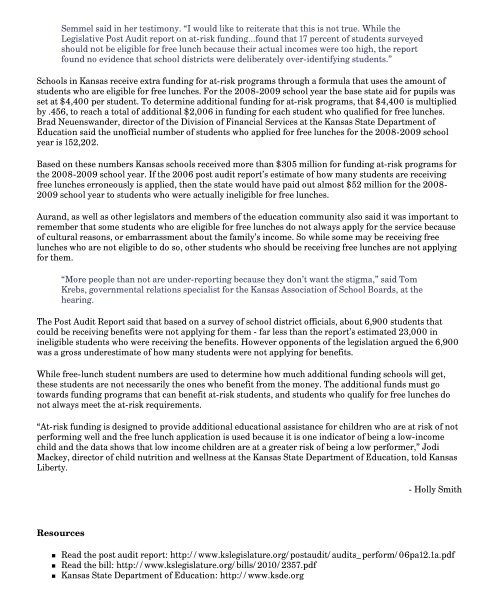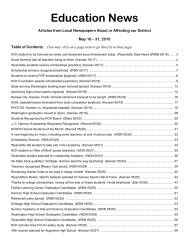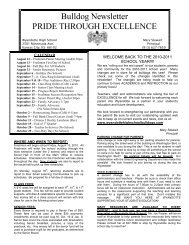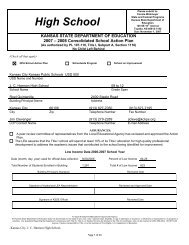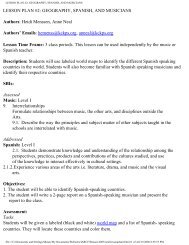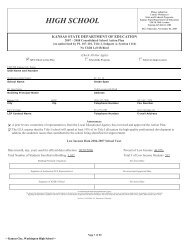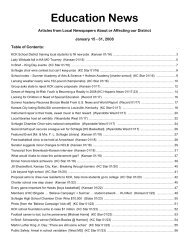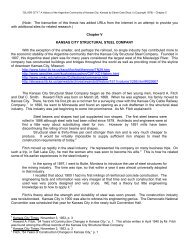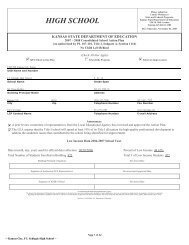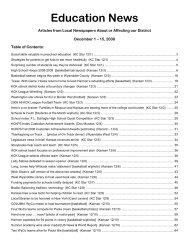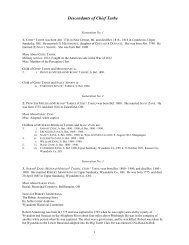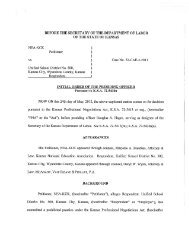March 1 - Kansas City, Kansas Public Schools
March 1 - Kansas City, Kansas Public Schools
March 1 - Kansas City, Kansas Public Schools
- No tags were found...
Create successful ePaper yourself
Turn your PDF publications into a flip-book with our unique Google optimized e-Paper software.
Semmel said in her testimony. “I would like to reiterate that this is not true. While theLegislative Post Audit report on at-risk funding…found that 17 percent of students surveyedshould not be eligible for free lunch because their actual incomes were too high, the reportfound no evidence that school districts were deliberately over-identifying students.”<strong>Schools</strong> in <strong>Kansas</strong> receive extra funding for at-risk programs through a formula that uses the amount ofstudents who are eligible for free lunches. For the 2008-2009 school year the base state aid for pupils wasset at $4,400 per student. To determine additional funding for at-risk programs, that $4,400 is multipliedby .456, to reach a total of additional $2,006 in funding for each student who qualified for free lunches.Brad Neuenswander, director of the Division of Financial Services at the <strong>Kansas</strong> State Department ofEducation said the unofficial number of students who applied for free lunches for the 2008-2009 schoolyear is 152,202.Based on these numbers <strong>Kansas</strong> schools received more than $305 million for funding at-risk programs forthe 2008-2009 school year. If the 2006 post audit report’s estimate of how many students are receivingfree lunches erroneously is applied, then the state would have paid out almost $52 million for the 2008-2009 school year to students who were actually ineligible for free lunches.Aurand, as well as other legislators and members of the education community also said it was important toremember that some students who are eligible for free lunches do not always apply for the service becauseof cultural reasons, or embarrassment about the family’s income. So while some may be receiving freelunches who are not eligible to do so, other students who should be receiving free lunches are not applyingfor them.“More people than not are under-reporting because they don’t want the stigma,” said TomKrebs, governmental relations specialist for the <strong>Kansas</strong> Association of School Boards, at thehearing.The Post Audit Report said that based on a survey of school district officials, about 6,900 students thatcould be receiving benefits were not applying for them - far less than the report’s estimated 23,000 inineligible students who were receiving the benefits. However opponents of the legislation argued the 6,900was a gross underestimate of how many students were not applying for benefits.While free-lunch student numbers are used to determine how much additional funding schools will get,these students are not necessarily the ones who benefit from the money. The additional funds must gotowards funding programs that can benefit at-risk students, and students who qualify for free lunches donot always meet the at-risk requirements.“At-risk funding is designed to provide additional educational assistance for children who are at risk of notperforming well and the free lunch application is used because it is one indicator of being a low-incomechild and the data shows that low income children are at a greater risk of being a low performer,” JodiMackey, director of child nutrition and wellness at the <strong>Kansas</strong> State Department of Education, told <strong>Kansas</strong>Liberty.- Holly SmithResources• Read the post audit report: http://www.kslegislature.org/postaudit/audits_perform/06pa12.1a.pdf• Read the bill: http://www.kslegislature.org/bills/2010/2357.pdf• <strong>Kansas</strong> State Department of Education: http://www.ksde.org


